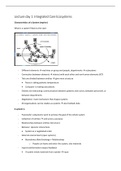Lecture day 1: Integrated Care Ecosystems
Characteristics of a System (reprise)
What is a system? Back to the start
- Different elements → machines or group and people, departments → subsystems
- Connection between elements → interact with each other and non-human elements (ICT)
- Taks are divided between entities → give more structure
• Nurse is taking patients temperature
• Computer is making calculations
- Entities are interacting: communication between patients and nurses, between personnel, or
between departments
- Negotiation: main mechanism that shapes systems
- All organisations can be studies as systems → also football clubs
A system is
- Purposeful: subsystems work to achieve the goal of the whole system
- Collection of entities → and serves a purpose
- Relationships between entities (structure)
- Behavior: dynamic interactions
• System as a negotiated order
- External environment (open systems)
• Boundaries allow Exchange + Relationships
o People can leave and enter the system, also materials
- Input-transformation-output-feedback
• If system needs materials from outside → input
, • System transfers inputs into outputs → such as services
• Output leaves system trough boundaries
- Process, Flow → flow is the steady stream of materials → unhampered movement of
resources and materials through the process → ineens wordt operatie uitgesteld en dan gaat
patient niet meer unhampered door het process → het is hampered
- System can change
• Mergers → system boundaries change
- System is dynamic
- Healthcare providers organization, insurers → all systems → all have connections
Banathy’s Systems
Classification of systems (Banathy 1996)
- Natural - Designed
• Natural: e.g. subatomic, fauna, planets, universe → living systems
• Designed: created by humans
- Designed systems
• Fabricated physical systems (e.g. neighborhood)
• Hybrid systems (combines nature and physical constructions, e.g. hydroelectric power
plant)
• Designed conceptual systems (theories, philosophies)
• Human activity systems → relevant for this lecture and course
, ➔ Five types of human activity systems
➔ Become more open, and more degrees of freedom, decision making power
➔ The more freedom among workers, the more decision making power they have on
operational objectives (targets for a unit of department in hospital, number of daily hip
surgeries)
➔ Close to open: boundaries are more permeable and more interaction with environment
So far: Organisation = System, and departments etc are sub-systems
However, increasingly we see inter-organisational systems, i.e. systems of organisational systems
- In which organisations are sub-systems of interorganisational systems
- Integrated care for example
So, whether an entity is a system or subsystem depends on where you draw the system boundary
Integrated Care Ecosystems
Interorganisational systems: Integrated Care (Singer et al. 2011)
Patient care, that is
- Coordinated across professionals, facilities, and support systems
- Continuous over time and between visits
- Tailored to the patients and family members’ needs and preferences
- Based on shared responsibility between patient and caregivers for optimizing health
- Why important?
- Difficult – why?
Importance of Integrated Care (Tietschert et al., 2016)
➔ Integrated: achieving unity of effort between subsystems, to complete a task and achieve
a common goal
“Greatest challenge”
- Greatest challenge: Meeting complex needs of patients with chronic illness or impairment
- Chronic patients’ needs require multiple services
- Due to specialisation + professionalisation needs cannot be addressed by 1 professional or
organisation alone → specialization leads to fragmentation → gap between specialization
and complex needs become wider
- So, Integrated care became indispensable → give rise to many initiatives
, - Many initiatives all over the world
Integrated care requires
- Processes and flow between/across professional groups and organisations
Integrated care Ecosystems (Mohr and Dessers, 2019)
Ecosystem: one or more central companies who take the lead. The other organizations value the
function of the ecosystem leaders because it enables them to move to shared visions and their
investments → according to more
Other authors other definitions → for example no leader → non-hierarchical → it has a purpose and
different levels
➔ Interdependent organisations
➔ Hardly any hierarchy
Dynamic and co‐evolving communities
- Of sovereign and unique organizations, independent care providers, informal care givers,
care networks, patients and others
- Which co‐produce care or develop care innovations
- Related to a specific or to multiple patient population(s)
- With requisite levels of care process integration and coordination
- Within unique social, physical and systemic conditions
- Which are highly effective at achieving the aim





